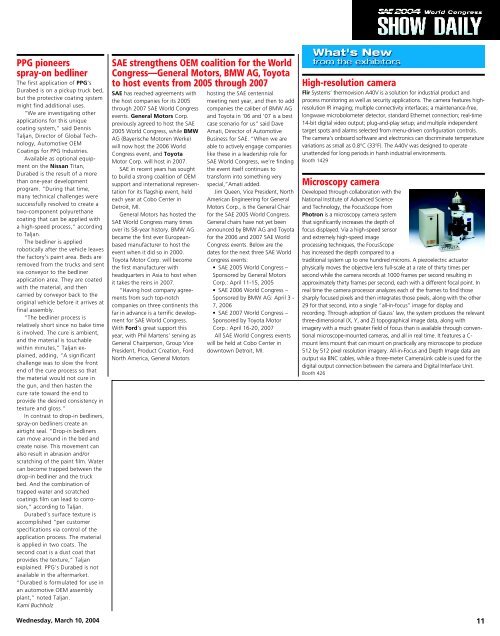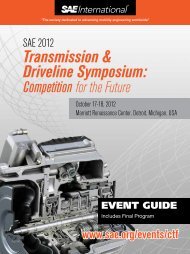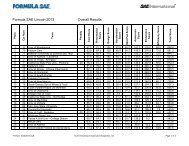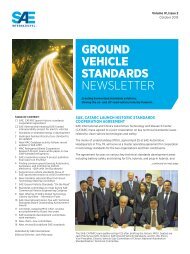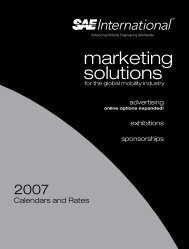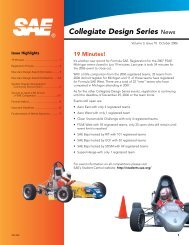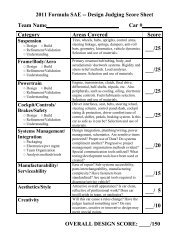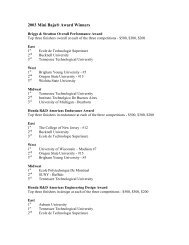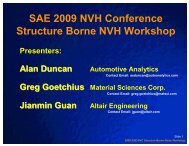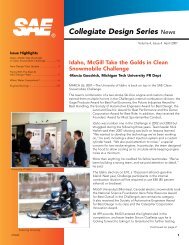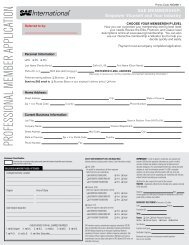Wednesday - SAE
Wednesday - SAE
Wednesday - SAE
Create successful ePaper yourself
Turn your PDF publications into a flip-book with our unique Google optimized e-Paper software.
PPG pioneers<br />
spray-on bedliner<br />
The first application of PPG’s<br />
Durabed is on a pickup truck bed,<br />
but the protective coating system<br />
might find additional uses.<br />
“We are investigating other<br />
applications for this unique<br />
coating system,” said Dennis<br />
Taljan, Director of Global Technology,<br />
Automotive OEM<br />
Coatings for PPG Industries.<br />
Available as optional equipment<br />
on the Nissan Titan,<br />
Durabed is the result of a more<br />
than one-year development<br />
program. “During that time,<br />
many technical challenges were<br />
successfully resolved to create a<br />
two-component polyurethane<br />
coating that can be applied with<br />
a high-speed process,” according<br />
to Taljan.<br />
The bedliner is applied<br />
robotically after the vehicle leaves<br />
the factory’s paint area. Beds are<br />
removed from the trucks and sent<br />
via conveyor to the bedliner<br />
application area. They are coated<br />
with the material, and then<br />
carried by conveyor back to the<br />
original vehicle before it arrives at<br />
final assembly.<br />
“The bedliner process is<br />
relatively short since no bake time<br />
is involved. The cure is ambient,<br />
and the material is touchable<br />
within minutes,” Taljan explained,<br />
adding, “A significant<br />
challenge was to slow the front<br />
end of the cure process so that<br />
the material would not cure in<br />
the gun, and then hasten the<br />
cure rate toward the end to<br />
provide the desired consistency in<br />
texture and gloss.”<br />
In contrast to drop-in bedliners,<br />
spray-on bedliners create an<br />
airtight seal. “Drop-in bedliners<br />
can move around in the bed and<br />
create noise. This movement can<br />
also result in abrasion and/or<br />
scratching of the paint film. Water<br />
can become trapped between the<br />
drop-in bedliner and the truck<br />
bed. And the combination of<br />
trapped water and scratched<br />
coatings film can lead to corrosion,”<br />
according to Taljan.<br />
Durabed’s surface texture is<br />
accomplished “per customer<br />
specifications via control of the<br />
application process. The material<br />
is applied in two coats. The<br />
second coat is a dust coat that<br />
provides the texture,” Taljan<br />
explained. PPG’s Durabed is not<br />
available in the aftermarket.<br />
“Durabed is formulated for use in<br />
an automotive OEM assembly<br />
plant,” noted Taljan.<br />
Kami Buchholz<br />
<strong>Wednesday</strong>, March 10, 2004<br />
<strong>SAE</strong> strengthens OEM coalition for the World<br />
Congress—General Motors, BMW AG, Toyota<br />
to host events from 2005 through 2007<br />
<strong>SAE</strong> has reached agreements with<br />
the host companies for its 2005<br />
through 2007 <strong>SAE</strong> World Congress<br />
events. General Motors Corp.<br />
previously agreed to host the <strong>SAE</strong><br />
2005 World Congress, while BMW<br />
AG (Bayerische Motoren Werke)<br />
will now host the 2006 World<br />
Congress event, and Toyota<br />
Motor Corp. will host in 2007.<br />
<strong>SAE</strong> in recent years has sought<br />
to build a strong coalition of OEM<br />
support and international representation<br />
for its flagship event, held<br />
each year at Cobo Center in<br />
Detroit, MI.<br />
General Motors has hosted the<br />
<strong>SAE</strong> World Congress many times<br />
over its 58-year history. BMW AG<br />
became the first ever Europeanbased<br />
manufacturer to host the<br />
event when it did so in 2000.<br />
Toyota Motor Corp. will become<br />
the first manufacturer with<br />
headquarters in Asia to host when<br />
it takes the reins in 2007.<br />
“Having host company agreements<br />
from such top-notch<br />
companies on three continents this<br />
far in advance is a terrific development<br />
for <strong>SAE</strong> World Congress.<br />
With Ford’s great support this<br />
year, with Phil Martens’ serving as<br />
General Chairperson, Group Vice<br />
President, Product Creation, Ford<br />
North America, General Motors<br />
hosting the <strong>SAE</strong> centennial<br />
meeting next year, and then to add<br />
companies the caliber of BMW AG<br />
and Toyota in ’06 and ’07 is a best<br />
case scenario for us” said Dave<br />
Amati, Director of Automotive<br />
Business for <strong>SAE</strong>. “When we are<br />
able to actively engage companies<br />
like these in a leadership role for<br />
<strong>SAE</strong> World Congress, we’re finding<br />
the event itself continues to<br />
transform into something very<br />
special,”Amati added.<br />
Jim Queen, Vice President, North<br />
American Engineering for General<br />
Motors Corp., is the General Chair<br />
for the <strong>SAE</strong> 2005 World Congress.<br />
General chairs have not yet been<br />
announced by BMW AG and Toyota<br />
for the 2006 and 2007 <strong>SAE</strong> World<br />
Congress events. Below are the<br />
dates for the next three <strong>SAE</strong> World<br />
Congress events:<br />
• <strong>SAE</strong> 2005 World Congress –<br />
Sponsored by General Motors<br />
Corp.: April 11-15, 2005<br />
• <strong>SAE</strong> 2006 World Congress –<br />
Sponsored by BMW AG: April 3 -<br />
7, 2006<br />
• <strong>SAE</strong> 2007 World Congress –<br />
Sponsored by Toyota Motor<br />
Corp.: April 16-20, 2007<br />
All <strong>SAE</strong> World Congress events<br />
will be held at Cobo Center in<br />
downtown Detroit, MI.<br />
High-resolution camera<br />
Flir Systems’ thermovision A40V is a solution for industrial product and<br />
process monitoring as well as security applications. The camera features highresolution<br />
IR imaging; multiple connectivity interfaces; a maintenance-free,<br />
longwave microbolometer detector, standard Ethernet connection; real-time<br />
14-bit digital video output; plug-and-play setup; and multiple independent<br />
target spots and alarms selected from menu-driven configuration controls.<br />
The camera’s onboard software and electronics can discriminate temperature<br />
variations as small as 0.8°C (33°F). The A40V was designed to operate<br />
unattended for long periods in harsh industrial environments.<br />
Booth 1429<br />
Microscopy camera<br />
Developed through collaboration with the<br />
National Institute of Advanced Science<br />
and Technology, the FocusScope from<br />
Photron is a microscopy camera system<br />
that significantly increases the depth of<br />
focus displayed. Via a high-speed sensor<br />
and extremely high-speed image<br />
processing techniques, the FocusScope<br />
has increased the depth compared to a<br />
traditional system up to one hundred microns. A piezoelectric actuator<br />
physically moves the objective lens full-scale at a rate of thirty times per<br />
second while the camera records at 1000 frames per second resulting in<br />
approximately thirty frames per second, each with a different focal point. In<br />
real time the camera processor analyzes each of the frames to find those<br />
sharply focused pixels and then integrates those pixels, along with the other<br />
29 for that second, into a single “all-in-focus” image for display and<br />
recording. Through adoption of Gauss’ law, the system produces the relevant<br />
three-dimensional (X, Y, and Z) topographical image data, along with<br />
imagery with a much greater field of focus than is available through conventional<br />
microscope-mounted cameras, and all in real time. It features a C-<br />
mount lens mount that can mount on practically any microscope to produce<br />
512 by 512 pixel resolution imagery. All-in-Focus and Depth Image data are<br />
output via BNC cables, while a three-meter CameraLink cable is used for the<br />
digital output connection between the camera and Digital Interface Unit.<br />
Booth 426<br />
11


